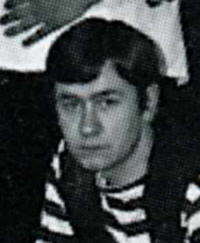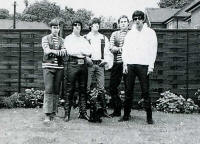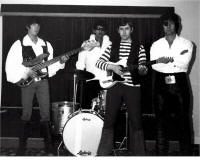The next day was spent trying to locate ace guitarist Mick Keane. Since I first met him at Battersea Fun Fair with Rich Bennett, Mick had played on several hit records, becoming a highly regarded player, particularly on the session scene. I was still buzzing after the meeting with Johnny Kidd and felt like someone who had won the football pools! By the end of the day, after countless telephone calls, it seemed that no one knew where Mick was, or even what he was up to. After some discussion with the other we realized that we would have to think again. I recall Solly and I both coming up with the same name, a guy we had known for several years who, like us, rated Johnny Kidd and the Pirates above all other acts, and who, like us, knew all his songs inside out! Mick Stewart was a professional player who had gigged with several different outfits, none of which had risen to great heights, but nevertheless he was recognized as a reliable solid picker who also looked good and could sing reasonably well.

Occasionally I would bump into Mick in Jim Marshall’s shop and I remember that we sometimes fantasized about being in Kidd’s band, just as today’s young players might fantasize about joining Led Zeppelin or AC/DC. When I telephoned Mick to offer him the job I could sense the excitement in his voice, but he insisted on keeping cool, saying that he would think about it and call me back. I countered this charade by telling him to be quick because we had to find someone fast! Of course he was pretty swift in calling back and the Pirates line-up was complete!
I called Kidd immediately with the news and we planned a rehearsal for the following morning, arranging to meet in the café at the end of Johnny’s road. As we ate breakfast together in the café, a blue Commer van pulled up outside. “You are about to meet”, said Kidd seriously, “the world’s greatest road manager!” Through the door came a wiry, confident, tough looking character, and I was introduced to the man who was to become one of my greatest friends. “Meet Johnny Irving, or Irvo, for short” said Kidd, and we all shook hands. Swiftly finishing our food, we loaded our gear into the bandwagon, all piled in, and with Irvo at the wheel, set off for the local church hall where we would show Kidd what we were capable of.
Nervously setting up and tuning up, we all knew that in spite of what had been said, if we failed to impress Kidd, then the deal would be off! One thing in our favour though was our knowledge of Kidd’s repertoire, having bought all the records, played them live where possible, and witnessed John’s act many times. He and Irvo could not have been more charming, and soon put us at ease. Once we had routined a few songs, our confidence grew and before long it was obvious that we all really clicked! Not surprising really, as Solly, Ray and myself had worked together so successfully as Regents and Bergeracs! I had a printed running order of the act, to which Kidd added a couple of comments, reminding us where to kick our legs out together, and not to forget the vocal “Oh Yeahs” in Dr. Feelgood.
After about six exhausting hours we called it a day, and once again climbed aboard the Pirates’ bandwagon. In those days the Commer van was the favourite vehicle of bands across the country. Kidd had modified his by fitting one of the first car record players next to the radio. It played 4 rpm singles with the centres removed (juke box style), which slid into a slot in the same way a cassette tape or CD is played today. The pickup weighed as much as a house brick, in order to stop the needle jumping on bumpy roads. Of course the record would be destroyed after about fifty plays, but that was all there was in those days, and if you had one you were the envy of the neighbourhood! Near the sliding side door was a steel tube, welded to the floor, over which several hundred records were stacked, every one a rock classic! As we pulled away to the strains of Johnny Otis singing “Castin’ My Spell”, I looked nervously at Kidd, and asked him if we had passed the audition. “You’ve passed with flying colours!” was his answer. “I know that we don’t have Mick Green…” I began, about to praise the assets that we did have, when he interrupted, “Don’t ever worry about my past musicians”, he said, “you guys are the business!”
Back at Johnny’s house, we toasted one another with cups of tea. There was no doubt that our performance had made the right impression, and our fantasy was now reality – we were the Pirates!
Still giddy with euphoria, I worked my last week at Ryman’s, bid the office staff a last farewell and got down to the serious business of being a pro once more. May 14th soon rolled around and the new line-up of Johnny Kidd & The Pirates headed out for their debut gig at a large ballroom in Bromley, Kent. Johnny was worried, having recently announced in the national press that he was changing his image. He had even generously allowed is previous Pirates to keep the name, in order that they could carry on working. However, according to Johnny Irving, Kidd was so rejuvenated by our arrival that he knew the image he had built up so successfully just had to be retained now.
Ray and Roger watched Mick and me nervously tuning up in the dressing room, whilst Kidd, fully resplendent in his stage outfit, languished in front of his portable TV set. Several other groups were on the bill and as people moved around the large dressing room I could sense the aura of respect which Kidd commanded. When the time came for us to take the stage I felt more nervous than ever before. Somehow I managed to croak my way through my first Regents’ single, “She’s About A Mover”, before Mick Stewart launched into the Ike & Tina Turner classic, “Something You’ve Got”. Then it was time for me to introduce Johnny Kidd, the crowd almost drowning out the intro to “I’ll Never Get Over You”, Kidd’s last top 5 hit. Exuding his usual air of menace, Kidd gave an amazing demonstration of stage craft, honed by ten years’ experience, as he effortlessly worked his way through the set. The new Pirates’ nervousness was compounded by the fact that our stage clothes were a bit below par, having hastily gathered a rag-bag of vaguely piratical outfits, which had to pass muster until we were able to get better stuff. Nevertheless, our debut gig went down a storm, and Kidd was more than pleased!

During the following week we were taken to Anello & Davide, the famous theatrical costumiers in London’s Drury Lane, where Kidd allowed us to pick out whatever we needed. We wandered around vast rows of costumes, like kids let loose in a sweet shop, picking out the items needed to turn us into real 18th Century pirates. The main item needed was a good pair of boots, Mick, Ray and Solly picking soft suede, whilst I chose black leather thigh boots. Mick and Ray opted to wear the blue and white striped matelot shirts, Solly going for velvet shirts with balloon sleeves. Johnny had given me one of his own stage shirts and pointed out how easily they could be made, so I swiftly recruited my mother to run up one on her sewing machine. By removing the sleeves from a regular white shirt and replacing them with huge balloon sleeves made from an old bedsheet, Mum created the ultimate pirate shirt, finished off with lace at the cuffs and collar. Johnny had given us large-buckled wide belts which he insisted were to be worn low, in order as he put it, to “lower our waists”. Half the contents of a can of spray starch made sure that my enormous sleeves stayed enormous. It was quite amazing how my kit transformed me from a nine-stone weakling into a menacing hulk!
Following more rehearsals, our confidence had grown one hundred per cent, when, on May 20th we headed off for our second gig, at the Royal Albion Ballroom, Walton-on-the-Naze, in Essex. Kidd was delayed that night, so Irvo and the boys set off in the van, whilst I picked up Johnny in my Austin Mini-van. During our high-speed dash to get there in time, Johnny coolly opened a bottle of beer with the window open. The contents immediately exploded from the bottle, giving the pair of us a 70 mph soaking!
On arriving at the packed hall we soon got changed and prepared for the show. Johnny taught us how to apply stage makeup, known as “slap”. He was very aware of stage craft and imagery, making full use of the stage lights. He was probably one of the first rock artists to realize the importance of lighting, and almost definitely the first in England to use ultra-violet light, having purchased one from Sweden several years before. Today everyone is familiar with UV, but in 1966 it was rarely if ever seen, leading to many people thinking that we wore ghostly “luminous” clothes!
Johnny’s stage appearance was completed by the addition of an amazing wig, known as the “Syrup” (of fig), for which he had paid over £100, an enormous sum back then. Whilst he still had plenty of his own hair, Johnny had the benefit of being able to leave the dressing room minus wig, and walk through the crowd completely unrecognized. It was during the Royal Albion gig that disaster almost struck! The stage had a canopy of tree branches above it, probably left over from a previous production, and when Kidd made his customary leap into the air during “Shakin’ All Over”, his wig snagged on a branch and lifted several inches above his head. Luckily Irvo always used a flashing strobe light at this point and so only a few people at the front noticed anything amiss, but those that did wondered if their eyes were playing tricks! The show ended without further mishaps and, elated by the audience response to only our second gig, we headed for home.
fig), for which he had paid over £100, an enormous sum back then. Whilst he still had plenty of his own hair, Johnny had the benefit of being able to leave the dressing room minus wig, and walk through the crowd completely unrecognized. It was during the Royal Albion gig that disaster almost struck! The stage had a canopy of tree branches above it, probably left over from a previous production, and when Kidd made his customary leap into the air during “Shakin’ All Over”, his wig snagged on a branch and lifted several inches above his head. Luckily Irvo always used a flashing strobe light at this point and so only a few people at the front noticed anything amiss, but those that did wondered if their eyes were playing tricks! The show ended without further mishaps and, elated by the audience response to only our second gig, we headed for home.
During the following week I was introduced to our publicist, Keith Goodwin, who handled the press for a stable of established acts. I was given the job of liaising with KayGee, as the firm was known, with Keith or his assistant telephoning me each week to discuss gigs and any reportable happenings. If there was little news, then something would be created to keep our name in the music press. To celebrate the boost to his career, Roger Truth purchased a new Ludwig drum kit. Solly had always been one of the loudest drummers in the business whilst playing a Premier kit, but the increase in sound level with the new kit led us all to turn up the volume. Mick Stewart boosted his Fender twin amp with an extra Bassman cabinet, and with my Marshall 50 watt 4×12 the sound was much louder than any previous Pirates, giving Kidd a much heavier backing.
On May 27th we headed out for Wales at the crack of dawn. Back in 1966 only a few miles of the M4 motorway had been built, so it took all day to drive to Abergavenny. There, we were given a warm welcome, for Johnny was extremely popular in Wales, just as he was in Scotland. In fact, I do not remember a negative response, for without doubt he was one of rock’s most loved characters! The Abergavenny gig was a yearly bash, sponsored by the local hunt, which took place in a huge hilltop barn. A large lady introduced us as we took to the stage and proceeded to give us a couple of loud blasts with a hunting horn, the crowd roaring approval.

The next few months saw us continuing to develop the show, gaining in confidence and basking in the positive feeling which we knew had lifted Johnny’s career from the doldrums. He had experienced many highs and lows over the years, with more misses than hits on the recording front, but there was no doubt that with the new band he was on the rise again! The advantage of his unique stage act, plus the fact that he had written and recorded arguably Britain’s best rock anthem meant that he never needed to rely on hit records to be in demand. By now we had lost our nervousness at being the new boys, and were becoming accustomed to being a band that took no prisoners. I think we were all reasonably competent musicians by then, with Solly an exception, rapidly being recognized as one of the best rock drummers in the country. Coupled with our youth and sheer exuberance, this made us a force to be reckoned with!
It was after one particularly good gig that I overheard Kidd talking to a long-time fan. “Great sound, John” he said to Kidd. “Thanks”, Johnny replied, “That’s because these guys are the best Pirates I’ve ever had!” I can remember the effect those words had on me. 1966 had been a good year so far – things couldn’t get much better than this!
| Chapter 8 ← | → Chapter 10 |
